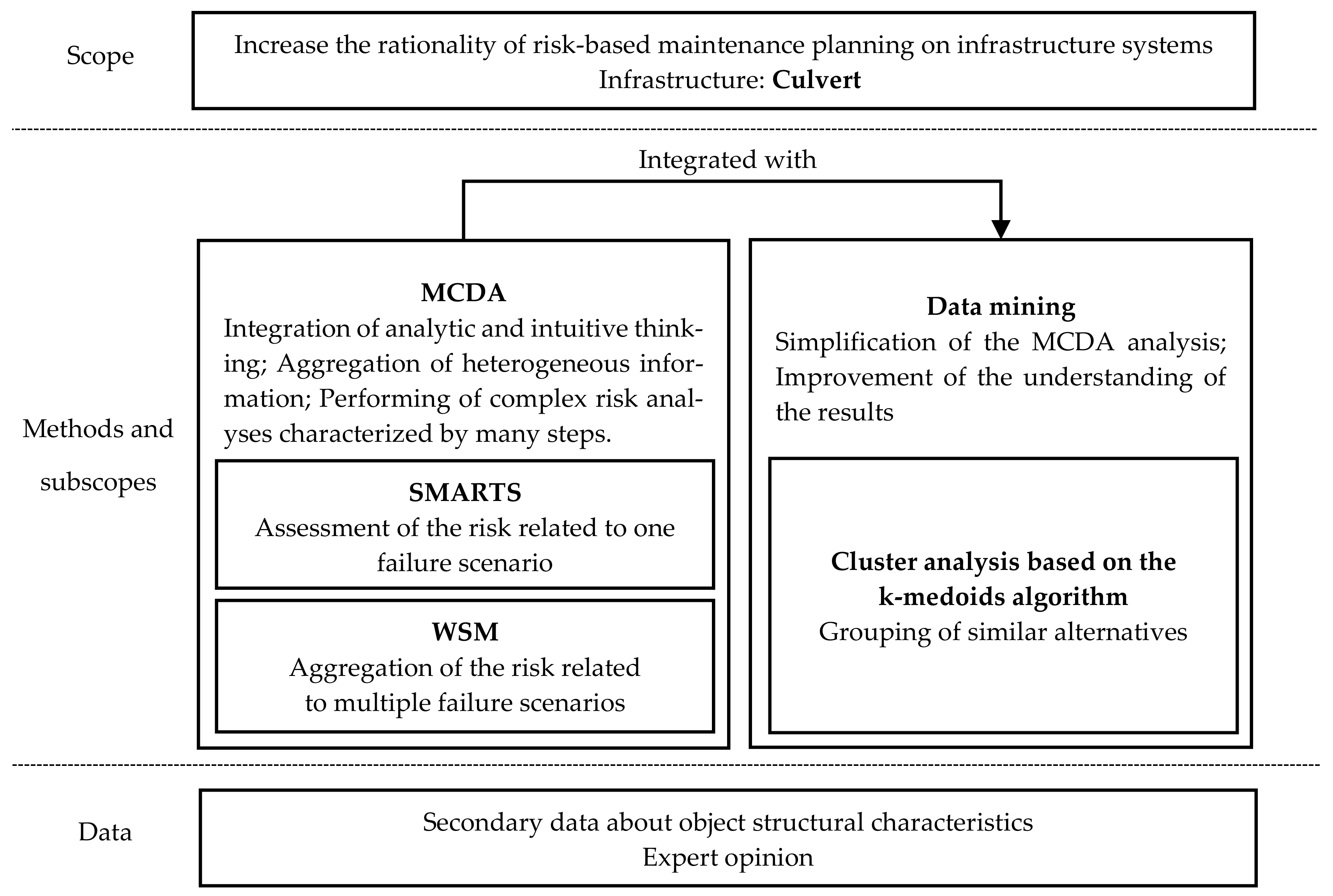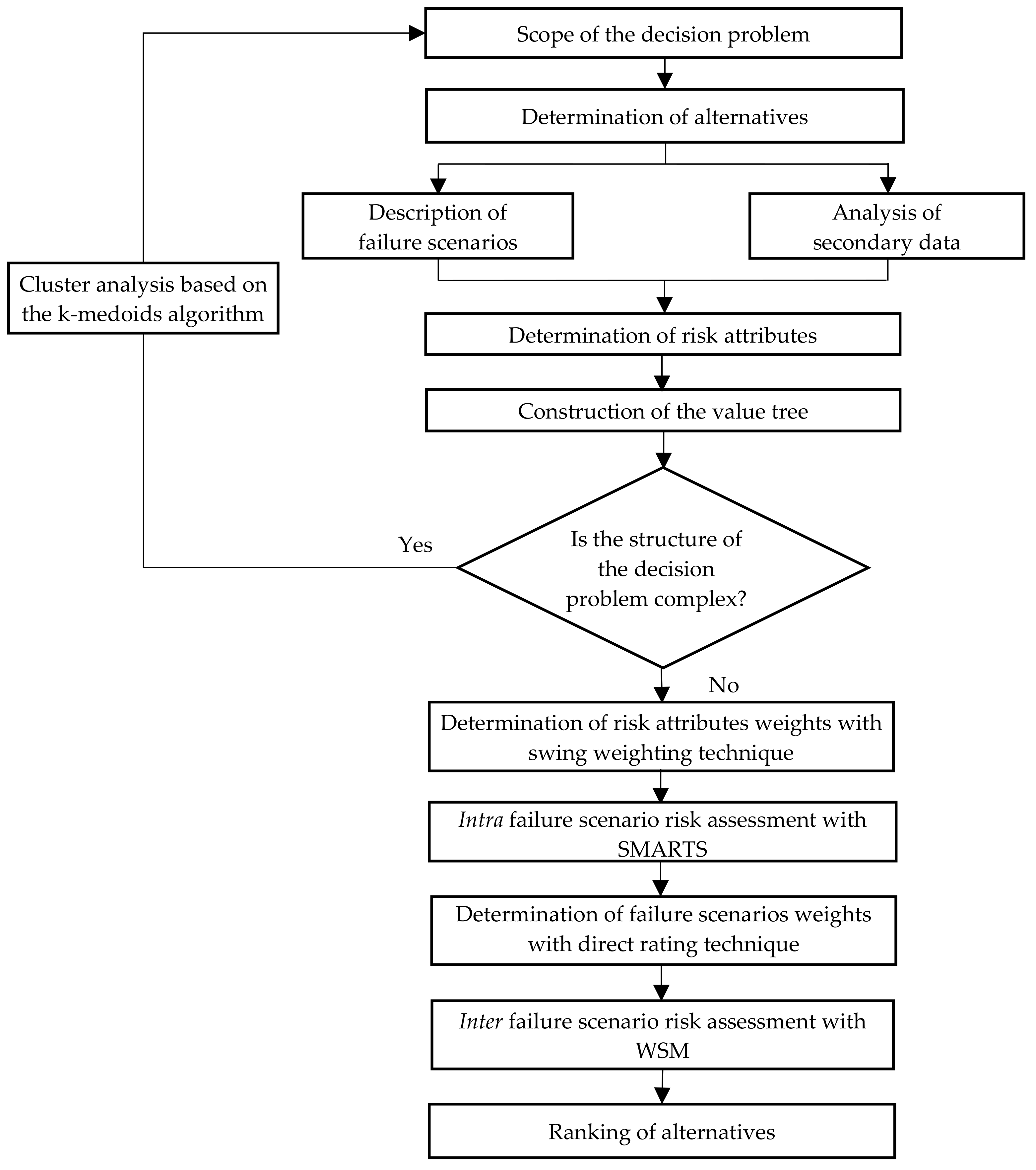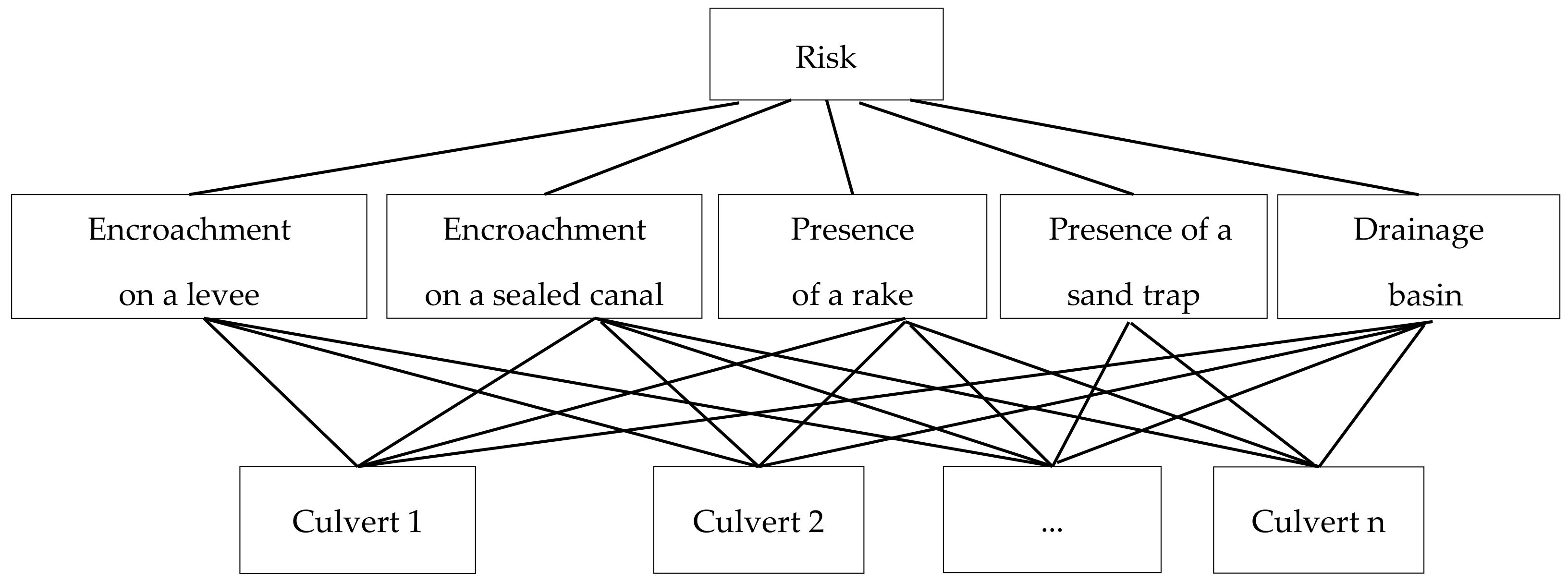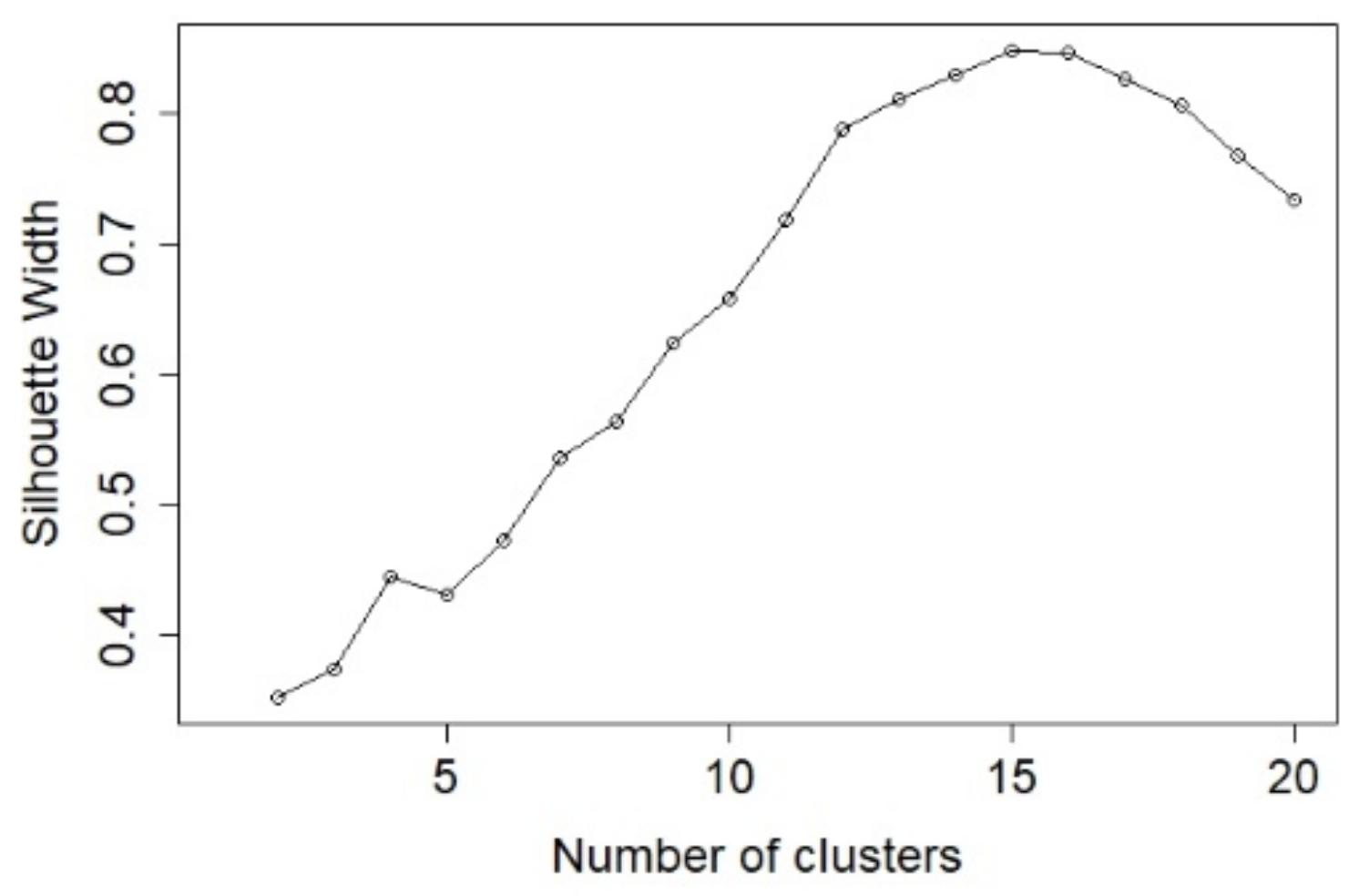1.1. Challenges in Infrastructure Management
Infrastructure management is a complex discipline which plays an essential role in the functioning and the well-being of modern societies. Among the activities that infrastructure management involves, maintenance management is becoming increasingly prevalent. In spite of the acknowledged fact that age affects the performance of civil infrastructures and their robustness against environmental and natural threats [
1], investments in maintenance are still insufficient [
2]. As a result, the maintenance backlog [
3], which represents the number of unfulfilled maintenance demands concerning predefined security standards, is growing.
The German waterways system also has to deal with a backlog accumulation of maintenance actions. The asset of waterways infrastructures, managed by the Federal Waterways and Shipping Administration of Germany (Wasserstraßen- und Schifffahrtsverwaltung des Bundes (WSV)) with the support of the Federal Waterways Engineering and Research Institute (Bundesanstalt für Wasserbau (BAW)), includes different types of infrastructures, such as locks, weirs, culverts, canal bridges, and lighthouses, for an estimated asset value of forty billion Euros. Inspections have pointed out that many infrastructures are or will soon be in bad condition. However, urgent maintenance interventions are systematically disregarded due to logistic and economic constraints. There are currently concerns about the culvert system, as it has often been neglected and the failure of one culvert could lead to flooding.
As in the case of extreme natural events or terrorism, disregarded maintenance might lead to the occurrence of unwanted consequences, and it is thus linked to a risk [
4]. Risk-based maintenance strategies have been developed to identify those system elements linked to higher probabilities of failure and the magnitude of failure consequences [
5]. However, the evaluation of risk is not trivial for infrastructure systems.
The status of risk as a mental construction, and the fact that the concept of risk spans different disciplines, from medicine to economics and engineering, has major implications that should be considered before starting any risk assessment. One such implication is the fact that, although the concept of risk has been the object of several studies and investigation, there is still not a single agreement about the definition of risk, as it clearly emerges from [
6,
7], where ten definitions of risk and five different examples of metrics are proposed, respectively. Nonetheless, most of those definitions and interpretations stem from the one given by [
8], who stated clearly that risk is a measure of the probability and severity of adverse effects. This definition also represents the basis of the one provided by [
9] and largely used nowadays, according to which risk can be quantified through a set of triplets: scenario, probability of failure, and consequence. This definition is as simple as it is ambiguous, since it can be interpreted in two different ways, which are both valid but imply different types of analysis [
10]: (1) in terms of the probability of occurrence of adverse effects; (2) in terms of the probability of the severity of adverse effects, given their occurrence. Regardless of the definition, risk assessment represents a true challenge in the case of complex systems. The real world is in effect constituted by interdependent and interconnected (I-I) complex systems of systems (SoS) [
11]. Each SoS is composed of many subsystems, each of which is characterized by a hierarchy of shared or interacting components having multiple states, functions, operations, databases, costs, and stakeholders. All SoS are subject to multiple adverse initiating events that could originate outside or inside the SoS. In contrast to a single system, no single model can capture the essence of SoS. Furthermore, the I-I subsystems share most of the previously mentioned building blocks and especially their states. In addition to these challenges, it should be considered that a clear separation between the probability and consequences of failure is difficult to achieve in practice. This is due to the fact that, despite the attempt to describe the world through simple, linear models, the causal chain describing failure scenarios is often non-linear, with chain links playing both the role of causes and effects at the same time and activating reinforcement loops.
As the assessment of the risk of neglecting maintenance supports decision making in infrastructure management and the planning of maintenance actions, strategies are needed that tackle these challenges and clarify the ambiguities inherent in the risk analysis of infrastructure systems.
1.2. The Multi-Criteria Decision Analysis for the Maintenance Management of Physical Infrastructures
Maintenance activities involve different types of decision problems which span from single choice to portfolio problematics and are often deeply combined and connected to each other. These decision problems are characterized by different decision criteria and involve short and long-term consequences, about which a certain degree of information is available. Considering that human beings can simultaneously process a limited amount of information, methods are needed which support decision making in maintenance management, which also capture the multidimensional nature of risk and increase the rationality of the decision process. A tool which can provide valuable help in many phases of the decision process concerning maintenance activities is the multi-criteria decision analysis (MCDA).
The MCDA represents a collection of formal approaches which seek to take explicit account of multiple criteria in helping individuals or groups explore decisions that matter. The MCDA provides an aid to decision making by pursuing the following objectives: (1) to integrate objective measurement with value judgment; (2) to make explicit and to manage the subjectivity inherent in decision making, especially in the choice of the criteria and their relative importance; (3) to illuminate controversy and overcome difficult trade-offs, e.g., by promoting the generation of new alternatives; (4) to increase decision makers’ learning and understanding of the decision problem and thus to promote the exploration of new capabilities; (5) to provide a structure for the decision problem which serves as a focus and a language for discussion.
The MCDA has been already applied to the maintenance of infrastructure systems [
12,
13]. MCDA methods differ in many aspects, such as the input information, the modelling effort required, as well as the outcome and its granularity. Depending on the outcome, they can be more suited for making choices, sorting and classification, ranking, elimination, design, or the description of problems. In general, all the MCDA approaches incorporate subjective information in the form of preferences. However, they follow different models, which can be grouped into three main categories: the value measurement models; the goal, aspiration or reference level models; the outranking models [
14]. In the context of maintenance management, the following applications have been recently developed: value measurement models are implemented in the maintenance management of railways, bridges, and roads [
13,
15,
16,
17]; goal, aspiration, or reference level models such as multi-objective programming methods are implemented in the maintenance management of bridges and highways [
18,
19]; outranking models are implemented in the maintenance management of bridges and roads [
20,
21]. The review of the literature shows a trend towards using value measurement models to prioritize maintenance actions on single objects, also considering the relevance of the object at network level.
However, the MCDA is suited to deal with small sets of simple and static qualitative and/or quantitative data. It is thus inadequate to process large amounts of complex data which nowadays are collected during the several stages of maintenance and infrastructure management [
22]. In addition, MCDA approaches have found limited implementation by government agencies, organizations, and institutions [
23]. Currently, decisions are taken quickly, instinctively, and emotionally, considering only a few of all the possible alternatives, and without collecting information or using the information available for properly describing the decision consequences. As decision problems are inherently complex and multidimensional, strong arguments have been made in favor of a methodological pluralism in which the MCDA is used in conjunction with other methods in order to expand their influence and their acceptance among practitioners [
24].
1.4. Integration of Data Mining Techniques in the Multi-Criteria Decision Analysis
Currently, there is a need to integrate the MCDA with other methods in order to enhance its practical value in operational research. Hybrid approaches in which MCDA is combined with artificial intelligence and data mining techniques have already been developed [
22,
27,
28]. A comprehensive collection of recent contributions in which the MCDA is supported by artificial and computational intelligence is especially given by [
28], in which several references to older approaches have also been provided. A review of the literature reveals that the integration has the practical purposes of improving the structure of the decision problem, performing data pre-processing, modeling the preferences. However, to date, hybrid MCDA has found almost no application in infrastructure management. Exceptions are represented by [
29], in which artificial neural networks support the MCDA to evaluate municipal water mains performance, and [
30], in which the MCDA and genetic algorithms are implemented together with other techniques in order to develop a multi-year maintenance planning for bridges. Nonetheless, the proposed methodologies lack integration and generality. The development of hybrid approaches in which the MCDA is integrated with artificial intelligence and data mining techniques could increase the objectivity of the decision process and thus enhance the practical value of the MCDA in the maintenance management of waterway infrastructures and in many other disciplines.
It should be mentioned that the social relevance of such integrated approaches has increased since the onset of the crisis due to the COVID-19 pandemic, as governments have been forced to make difficult choices that profoundly affect the health, wealth, and freedom of their populations. These high-stakes decisions have often been made quickly, without using sound information, and with little involvement of stakeholders in the deliberation about which policies to pursue. A more inclusive, objective, and data-driven decision-making process could contribute to more trustworthy and legitimate decisions on difficult ethical questions and political trade-offs during the pandemic and beyond [
31].
The aim of this paper is to increase the rationality of decision making in infrastructure management by developing a hybrid approach for risk-based maintenance planning in which the MCDA is integrated with data mining techniques. The integration of the two methodologies is aimed at reducing their weaknesses and exploiting their full potential. The great advantages of a combined approach are to make explicit the subjective component of decision making and to combine it with advanced data analysis.
The rest of this paper is organized as follows.
Section 2 presents the basic methodologies which have been integrated and combined to develop the hybrid approach for the risk assessment of aging infrastructures.
Section 3 describes the main features of the hybrid approach and its application to the maintenance prioritization of a system of aging culverts.
Section 4 summarizes the main findings of this work as well as its limitations and defines future research directions.










